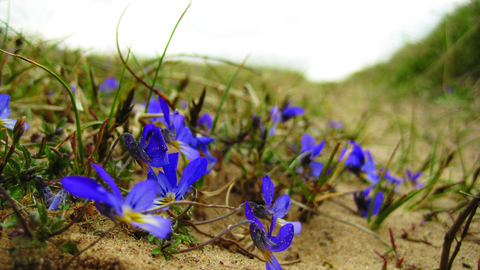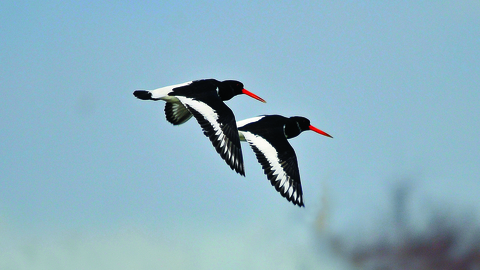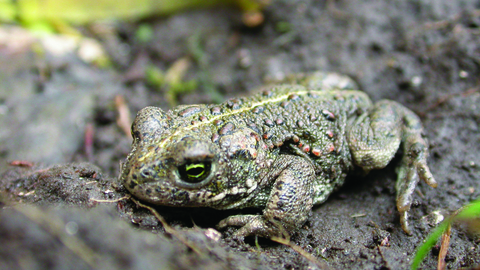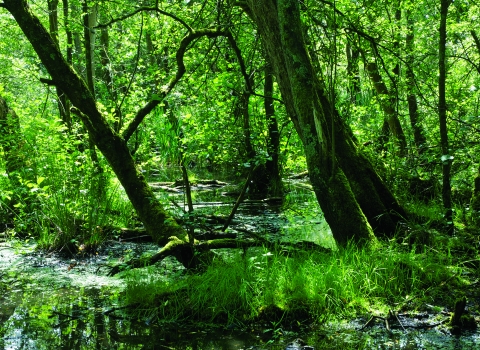IMPORTANT: If the red flag is flying, firing is taking place on the gun range and there is no access to the reserve. PLEASE RING THE GUN RANGE ON 01229 712200 BEFORE VISITING TO CHECK IF THE RESERVE IS OPEN.
The reserve is not accessible at high tide, so please check tide timetables before visiting.

© John Morrison

Wild pansy

Oystercatchers © Steve Waterhouse

Natterjack toads are rare but you have the opportunity to help conserve them © Philip Precey
Eskmeals Dunes
Location
OS Map Reference
1:50,000. Sheet no.96Grid reference: SD 085 943
Getting here
By car:
From the A595 at Waberthwaite, take the minor road through the village and continue for a further 2.3km/1.4 miles. Under the viaduct, the road swings left. Park here on the left-hand side and walk along the saltmarsh onto the reserve.
At high tides, this route may not be passable, in which case approach from Bootle village. In the village, take the minor road signed for Bootle Station. Follow the road to the coast then turn north and continue for a further 3.7km/2.3 miles. Park just before the viaduct on the right-hand side.
By bicycle:
The reserve is 16 km/9.5 miles from National Route 72 Hadrian’s Cycleway.
By public transport:
Trains run from Whitehaven and Millom to Ravenglass/Bootle Station. Buses run from Egremont, Gosforth and Seascale to Ravenglass.
View on What3Words
Know before you go
Dogs
When to visit
Opening times
When firing is taking place on the gun range, there is no access to the reserve so please call 01229 712200 before visiting to check the reserve is open. The reserve is not accessible at high tide so please check tide timetables before visiting.Best time to visit
April to July, October to FebruaryAbout the reserve
Wildlife highlights
- Natterjack toads – these rare amphibians breed in the small ponds on the nature reserve and can be spotted hunting for insects in the short grass.
- In spring - the dune grassland comes alive with wildflowers and the natterjack toads are spawning.
- In summer - birds such as ringed plover, skylark and wheatear are nesting. Look for butterflies warming themselves on the wild thyme! Dark green fritillary, gatekeeper, common blue and meadow brown are all commonly seen. Look out for pyramidal orchids amongst the grass.
- The estuary is an excellent feeding ground: look out for waders, such as ringed plover, curlew and oystercatcher, alongside ducks like wigeon and goldeneye that arrive from further north in winter.
- In autumn - migrating waders and wildfowl return to the reserve.
- In winter - a great time to see flocks of wintering birds on the estuary.
All year round you can see ringed plover and oystercatcher and, if you are lucky, an otter.
Dune system
Eskmeals Dunes formed around 5,000 years ago as sand built up on a shingle spit at the mouth of the river Esk.
The roots of the tall, stiff-leaved marram grass collect sand around them, building it up to form new dunes. Where the sand has been blown away ‘fossilised’ shingle ridges are revealed.
What makes Eskmeals Dunes so special?
These internationally important dunes are home to over 300 plant species.
Specialities found in the dune grassland include wild pansy, lady’s bedstraw and Portland spurge, while sea-lavender, thrift and glasswort occupy areas of saltmarsh.
Plants of the coast
The sand, shingle and saltmarsh of the nature reserve provide habitat for over 300 species of plant. Specialities of the dune grassland include heart's ease pansy, wild thyme, lady's bedstraw, and Portland spurge.
You can find pyramidal, bee and northern marsh orchids here too.
In the saltmarsh you can find sea lavender, thrift, sea purslane and glasswort.
On the wing
The profusion of flowers attracts a variety of insects and in summer dark green fritillary, gatekeeper, common blue and meadow brown butterflies are common.
The estuary is a valuable feeding area for wading birds such as curlew and oystercatcher and in the winter other birds such as wigeon and goldeneye arrive from further north to feed.
Stonechat, grey partridge and skylark breed on the nature reserve itself.
Around the ponds
The ponds on the reserve are home to frogs and toads as well as common and great-crested newts.
Eskmeals is also one of the few places in Cumbria you can see natterjack toads.
Look out also for dragonflies such as the common darter around the ponds.
Keeping it special
The nature reserve is grazed by domestic stock to maintain this diversity and rabbits also play an important part in maintaining short turf.
Non-native sea buckthorn, planted in the 1950s to stabilise the dunes, is gradually being removed from the nature reserve.
Eskmeals Dunes is leased by Cumbria Wildlife Trust from the Ministry of Defence and has been a nature reserve since 1970.
Species
Habitat
Contact us
Environmental designation
Upcoming events at Eskmeals Dunes Nature Reserve
If there are any upcoming events at Eskmeals Dunes Nature Reserve we'll show them to you below.

Support our conservation work on this nature reserve,
and protect Cumbria's wildlife & wild places.


